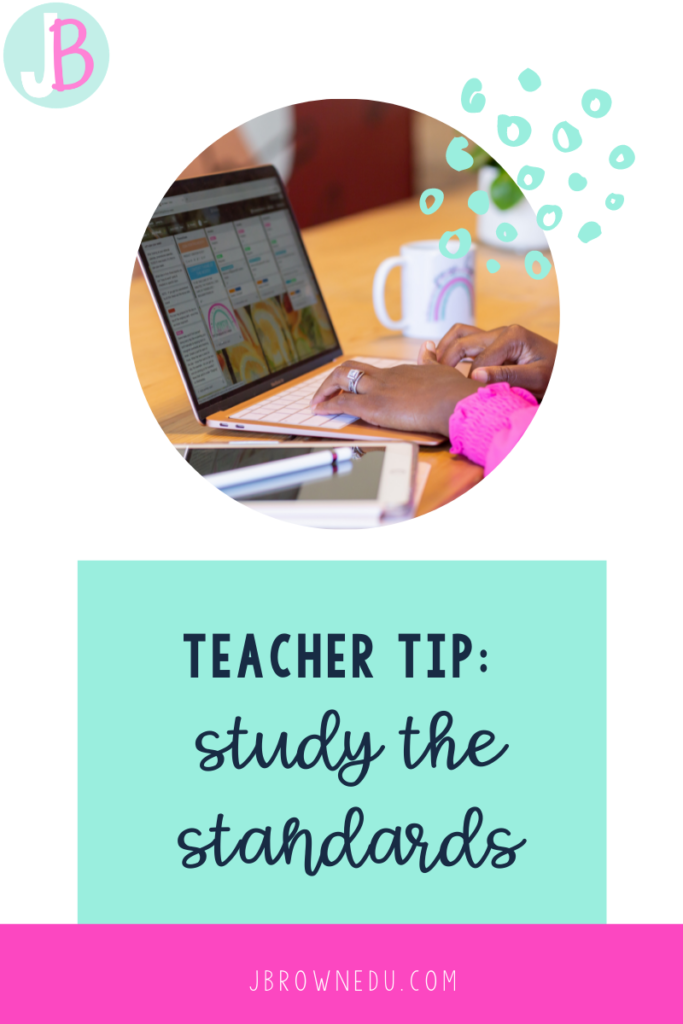Are you nervous about your first job teaching math? Whether this is the position that you interviewed for or were told that you have to now teach, welcome to the wonderful world of math. Teaching math now is much different than when I got my first job teaching math so I get it if you are nervous about this transition. If you aren’t nervous and you’re just looking for some cool ideas, then you’re in the right place. So keep on reading!

Believe it or not, my first year of teaching wasn’t this beautiful brand new job teaching math. I got the privilege of being a P.E. teacher. The only way to get my foot in the door at my school of choice was to accept a position teaching grades 3-5 P.E. and 4th-grade reading. I loved my students, but at the end of the day, it wasn’t where my passion was.
My First Year Experience
One of the students in my class was a troubled student. Let’s just call her Mary. Once she left, I always wondered where she’d gone. Fast forward a few years and I’m volunteering at a youth program for troubled teens. The very first day that I show up to volunteer, who do I see? MARY!
I ran over to her in excitement. She had no clue who I was. She didn’t remember me ever being her teacher. Such a gut punching moment. She was the second student from that school that didn’t remember me.
Have you ever had this happen to you? Or do you want to make sure that it doesn’t happen to you in your new job teaching math? You want your students to remember you, right? Throughout the years, I have figured out a few reasons why those students may not have remembered me. I’ve gotten much better at it, and I just get the privilege of doing it now as a math educator. So whether you are new to math or new to an online job teaching math, we are going to look at how to make it memorable for your students.
Don’t just love your students, show them that you love them.

I don’t mean being the push-over teacher. Really work at making meaningful connections with students that last throughout their lives. Maslow before Bloom. Bloom’s taxonomy is great, but we can’t bring students through this hierarchy of thinking if we haven’t taken care of their human needs. We don’t know how to take care of their needs if we aren’t intentionally building relationships with them. There are a few ways that I have figured out how to build intentional relationships that parents and students have raved about.
Implement zero week.
This is the first week of school where the only focus is on getting to know students and building relationships with them. I have found it to be extremely valuable. I give a survey/questionnaire and implement activities that would help me get to know them.
Have casual conversations with ALL students.
I do this by using the first 5 minutes of class to chat with students. I allow students to tell me what they are feeling emotionally and then I engage them in a conversation starter. For example, I would ask, “what is one thing that you notice about adults” or “what can I do to help you better.” Both of these questions have given me so much insight and serve as a springboard for decisions that I make in my classroom. Here is an idea of how I do this in a virtual setting using Desmos. It can also be used in a brick and mortar setting. You can give students a journal to respond in.
Give a teacher report card.
If students receive a report card, so do you. Each 9 weeks allow your students to score you. This will allow them to see that you are a learner as well. It will also help them see that you are human as well, and though mistakes are made, we learn from them. It’s a perfect way to model that for them.
For more ideas and information on building student relationships, you’ll love this blog post.
Be a positive learner and math educator

How cool is it that you get to learn with your students? This is such a perfect opportunity to model a growth mindset. This is a new experience for you, so give yourself some grace. In my class, I’m big on teaching a growth mindset. I embed it throughout the lesson. I have a quote of the month and we focus on it and find ways to apply it throughout the lesson. I’m also big on creating a classroom culture where it’s okay to make mistakes. We create that safe space that takes so much pressure off of students.
Because you will learn the content with your students, you can let them know that you are open about struggles that you may have had understanding new methods.
Be careful of the messages that are sent about math when you don’t quite understand the why behind something.
When you see a new strategy introduced that you aren’t familiar with, embrace it and have an eagerness to share it with the students in an enthusiastic way. Most of the standards won’t be taught the way that you learned it. Students will model the attitudes and behavior of their teacher.
Study the standards

The world of standards has changed so much. Most states currently use Common Core State Standards or state standards that are a derivative. Whatever your state or school uses, make sure to familiarize yourself with them. Once you dive into the standards and know the expectations, you can teach using any curriculum and it’ll make teaching lessons so much easier. There are 6 components of a standard that I would suggest identifying before planning a lesson.
1. Target Standard
Identify the standard that you are preparing to teach. Standards can tend to be wordy, so make sure to do a close read of it. Overlooking one word can change the intention of how it should be taught.
2. Standard Labels & Headings
Domain Names:
This refers to how standards are grouped and labeled that consist of related content. Domains are given as abbreviations in the standard. Below are examples of domain names.
Operations and Algebraic Thinking (OA)
Number and Operations in Base Ten (NBT)
Number and Operations – Fractions (NF)
Measurement and Data (MD)
Geometry (G)
Cluster Heading:
These headings are the letters that you see after the domain name. All of the standards within a domain that have related content will have the same cluster heading. For example, 3.OA.A.1 and 3.OA.A.2 have a domain name of Operations and algebraic Thinking (OA) and a cluster heading of A (represent and solve problems involving multiplication and division). Standard 3.OA.B.5 has the same domain name (OA) but has a different cluster heading. There’s a letter B after the domain abbreviation. Therefore the cluster heading is B (understand properties of multiplication and the relationship between multiplication and division).
Standard Classification
Identify the classification of the standard. Not all content is given the same amount of attention so the standards are classified. The categories are major work of the grade, supporting work, and additional work. We also want to be careful not to neglect any standard. Each standard holds value and sets a student up for success the next school year.
You can view the clusters for grades K-8 here.
Major Work of Grade-Green
- If a standard is in the major cluster, this means that it covers the major work of the grade. More time is spent on standards in this cluster because they take longer to master or they are taught in great depth. These standards are identified by being highlighted in green or a green box next to it.
Supporting Work- Blue
- Standards that are in the supporting cluster, support the learning of standards in the major cluster. They are often taught simultaneously, right before, or after, the major standard that it supports. They are associated with the color blue.
Additional Work- Yellow
- Additional standards are the ones that help to engage students in the major work of the grade. They are associated with the color yellow.
3. Component of Rigor
One major shift that came with CCSS is rigor. The components of rigor are conceptual understanding, procedural skill/fluency, and application. Knowing the component of rigor will help you know how to teach the standard. If the standard is conceptual, you’ll want to make sure you focus on using models. If a standard is procedural, your focus will be more on the algorithm.
4. Standard Alignment
Another major shift that came with CCSS is coherence. We want to make sure that we set students up for success in the future. Knowing the standards that are taught before and after a standard helps with coherence. Students should be able to see the connections and progression from one grade level to the next. We want to make sure to teach the standards in a way that aligns with the standard and is coherent. Make the coherence map your best friend. It works like magic!
5. Learning Target
After identifying the standard, what is a kid-friendly way to state the objective.? By the end of your lesson, what do you want students to know? These are also referred to as I can statements.
6. Success Criteria
What are the components of mastery for the standard? What are the components of work that shows that a student has mastered a standard? Once you can identify that, when you are looking at student work you will know exactly where to provide support for students that may present a struggle.
So how can all of these things make the year memorable for kids? When you build relationships and know what you are teaching, you can assist students in a more effective way. You can get closer to the root of their struggle personally and academically. Here’s to having a memorable experience in your first job teaching math for you and your students!

Are you thinking you’d like to try using motivational quotes and agenda slides for free before committing to it? I totally understand. You want to make sure that your students are really going to buy into it before you spend your coins on it. This is exactly why I decided to take a portion of my Activities for Social-Emotional Learning packet and gift it to you! Enneagram wing 1, coming through! Gift-giving is my love language. Begin below with your FREE Startup Kit. This will help decrease your students’ math anxiety and yours. It’ll make your first job teaching math the most memorable for your students.
Check out this video to find out how this teacher was awarded Teacher of the Year her very first year teaching and how she made it memorable!
Looking for more math strategies and tips? I’ve linked a few more here for you:
Vocabulary Strategies-
https://desertdesigned.net/2021/06/27/9-great-teaching-strategies-for-vocabulary-in-math/
Order of Operations-
Gamification-
Are you interested in writing your own blog post about your first job teaching math? Check out 7 Helpful Tips on How To Blog Like a Boss.

